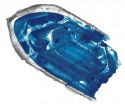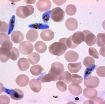(Press-News.org) MADISON, Wis. – With the help of a tiny fragment of zircon extracted from a remote rock outcrop in Australia, the picture of how our planet became habitable to life about 4.4 billion years ago is coming into sharper focus.
Writing today (Feb. 23, 2014) in the journal Nature Geoscience, an international team of researchers led by University of Wisconsin-Madison geoscience Professor John Valley reveals data that confirm the Earth's crust first formed at least 4.4 billion years ago, just 160 million years after the formation of our solar system. The work shows, Valley says, that the time when our planet was a fiery ball covered in a magma ocean came earlier.
"This confirms our view of how the Earth cooled and became habitable," says Valley, a geochemist whose studies of zircons, the oldest known terrestrial materials, have helped portray how the Earth's crust formed during the first geologic eon of the planet. "This may also help us understand how other habitable planets would form."
The new study confirms that zircon crystals from Western Australia's Jack Hills region crystallized 4.4 billion years ago, building on earlier studies that used lead isotopes to date the Australian zircons and identify them as the oldest bits of the Earth's crust. The microscopic zircon crystal used by Valley and his group in the current study is now confirmed to be the oldest known material of any kind formed on Earth.
The study, according to Valley, strengthens the theory of a "cool early Earth," where temperatures were low enough for liquid water, oceans and a hydrosphere not long after the planet's crust congealed from a sea of molten rock. "The study reinforces our conclusion that Earth had a hydrosphere before 4.3 billion years ago," and possibly life not long after, says Valley.
The study was conducted using a new technique called atom-probe tomography that, in conjunction with secondary ion mass spectrometry, permitted the scientists to accurately establish the age and thermal history of the zircon by determining the mass of individual atoms of lead in the sample. Instead of being randomly distributed in the sample, as predicted, lead atoms in the zircon were clumped together, like "raisins in a pudding," notes Valley.
The clusters of lead atoms formed 1 billion years after crystallization of the zircon, by which time the radioactive decay of uranium had formed the lead atoms that then diffused into clusters during reheating. "The zircon formed 4.4 billion years ago, and at 3.4 billion years, all the lead that existed at that time was concentrated in these hotspots," Valley says. "This allows us to read a new page of the thermal history recorded by these tiny zircon time capsules."
The formation, isotope ratio and size of the clumps — less than 50 atoms in diameter — become, in effect, a clock, says Valley, and verify that existing geochronology methods provide reliable and accurate estimates of the sample's age. In addition, Valley and his group measured oxygen isotope ratios, which give evidence of early homogenization and later cooling of the Earth.
"The Earth was assembled from a lot of heterogeneous material from the solar system," Valley explains, noting that the early Earth experienced intense bombardment by meteors, including a collision with a Mars-sized object about 4.5 billion years ago "that formed our moon, and melted and homogenized the Earth. Our samples formed after the magma oceans cooled and prove that these events were very early."
INFORMATION:
The new study was supported by grants from the National Science Foundation, Department of Energy and the NASA Astrobiology Institute.
—Terry Devitt, 608-262-8282, trdevitt@wisc.edu
NOTE: An image and infographic to accompany this story are available for download at http://www.news.wisc.edu/newsphotos/zircon-2014.html
Oldest bit of crust firms up idea of a cool early Earth
2014-02-23
ELSE PRESS RELEASES FROM THIS DATE:
Researchers have identified a novel immunological mechanism of great importance for vaccine developm
2014-02-23
Researchers have discovered the presence of a novel subtype of innate lymphoid cells in human spleen essential for the production of antibodies. This discovery, published in the prestigious journal Nature Immunology, clears the path to the identification of novel strategies to develop more efficient vaccines against encapsulated bacteria, considered highly virulent.
This work was done by the B cell Biology research group at IMIM (Institut Hospital del Mar d'Investigacions Mediques) in Barcelona, directed by Dr. Andrea Cerutti, ICREA research professor and leader in the ...
A key protein is discovered as essential for malaria parasite transmission to mosquitos
2014-02-23
Two teams have independently discovered that a single regulatory protein acts as the master genetic switch that triggers the development of male and female sexual forms (termed gametocytes) of the malaria parasite, solving a long-standing mystery in parasite biology with important implications for human health. The protein, AP2-G, is necessary for activating a set of genes that initiate the development of gametocytes -- the only forms that are infectious to mosquitos. The research also gives important clues for identifying the underlying mechanisms that control this developmental ...
Stream of stars in Andromeda satellite galaxy shows cosmic collision
2014-02-23
The Andromeda Galaxy is surrounded by a swarm of small satellite galaxies. Researchers from the Niels Bohr Institute, among others, have detected a stream of stars in one of the Andromeda Galaxy's outer satellite galaxies, a dwarf galaxy called Andromeda II. The movement of the stars tells us that what we are observing is the remnant of a merger between two dwarf galaxies. Mergers between galaxies of such low mass has not been observed before. The results are published in the scientific journal, Nature.
The galaxies in the early universe started off small and the theory ...
Researchers pinpoint brain region essential for social memory
2014-02-23
NEW YORK, NY (February 23, 2014) — Columbia University Medical Center (CUMC) researchers have determined that a small region of the hippocampus known as CA2 is essential for social memory, the ability of an animal to recognize another of the same species. A better grasp of the function of CA2 could prove useful in understanding and treating disorders characterized by altered social behaviors, such as autism, schizophrenia, and bipolar disorder. The findings, made in mice, were published today in the online edition of Nature.
Scientists have long understood that the hippocampus—a ...
Nanoparticles target anti-inflammatory drugs where needed
2014-02-23
Researchers at the University of Illinois at Chicago have developed a system for precisely delivering anti-inflammatory drugs to immune cells gone out of control, while sparing their well-behaved counterparts. Their findings were published online Feb. 23 in Nature Nanotechnology.
The system uses nanoparticles made of tiny bits of protein designed to bind to unique receptors found only on neutrophils, a type of immune cell engaged in detrimental acute and chronic inflammatory responses.
In a normal immune response, neutrophils circulating in the blood respond to signals ...
Climate change won't reduce deaths in winter
2014-02-23
New research published today (Sunday 23rd February) has found that climate change is unlikely to reduce the UK's excess winter death rate as previously thought.
The study is published in the journal Nature Climate Change and debunks the widely held view that warmer winters will cut the number of deaths normally seen at the coldest time of year.
Analysing data from the past 60 years, researchers at the University of Exeter and University College London (UCL) looked at how the winter death rate has changed over time, and what factors influenced it.
They found that from ...
Scientists unlock a 'microbial Pompeii'
2014-02-23
An international team of researchers have discovered a 'microbial Pompeii' preserved on the teeth of skeletons around 1,000 years old. The key to the discovery is the dental calculus (plaque) which preserves bacteria and microscopic particles of food on the surfaces of teeth, effectively creating a mineral tomb for microbiomes.
The research team discovered that the ancient human oral cavity carries numerous opportunistic pathogens and that periodontal disease is caused by the same bacteria today as in the past, despite major changes in human diet and hygiene.
The researchers ...
Christian Band The Sunrise to Perform at the 2014 Bringing America Back to Life Symposium
2014-02-23
The Sunrise will be performing at this year's Bringing America Back to Life Symposium and Exhibition presented by Cleveland Right to Life on March 7th, 2014 & March 8th, 2014.
The event features pro-life speakers including David Barton of WallBuilders, and Pam Tebow, mother of Tim Tebow. This is one of the nation's largest pro-life events of its kind, and the event completely sold out in 2013.
Those interested in attending this event can visit the Bringing America Back to Life website at: http://www.bringingamericabacktolife.org/index.html
In addition, The ...
Victory Over Stroke Symposium Set for March 20, 2014
2014-02-23
The Stroke Association of Florida has announced its Fifth Annual Victory Over Stroke symposium, scheduled for Thursday, March 20, 2014, 9 a.m. to 1 p.m., at H2U Blake Medical Center, 6670 Cortez Road W. in Bradenton, Florida.
Ana M. Guillermo, H2U Program Manager, will emcee the free event, which includes presentations from distinguished local speakers, free stroke risk health screenings and exhibitors. Lunch will be provided.
"The goal of Victory Over Stroke is to raise awareness about stroke symptoms and the critical need to call 911, what you can do to minimize ...
LongIslandObamacare.com: New Site and Upcoming Seminars to Help Long Islanders Navigate Healthcare Roll Out Issues, Offer Solutions
2014-02-23
LongIslandObamacare.com is the new informational, fact based, non-partisan site for Long Islanders trying to navigate through the new world order of heath insurance, created by local experts in the field. Jason Samel, Founder and spokesperson of LongIslandObamacare.com and Owner/Executive Vice President of JayMar Insurance Agency will be offering solutions and comments on the subject through an exclusive free seminar series, available to any group who is looking for a fact based education on all things the Affordable Care Act/Obamacare, happening through the New York City ...



